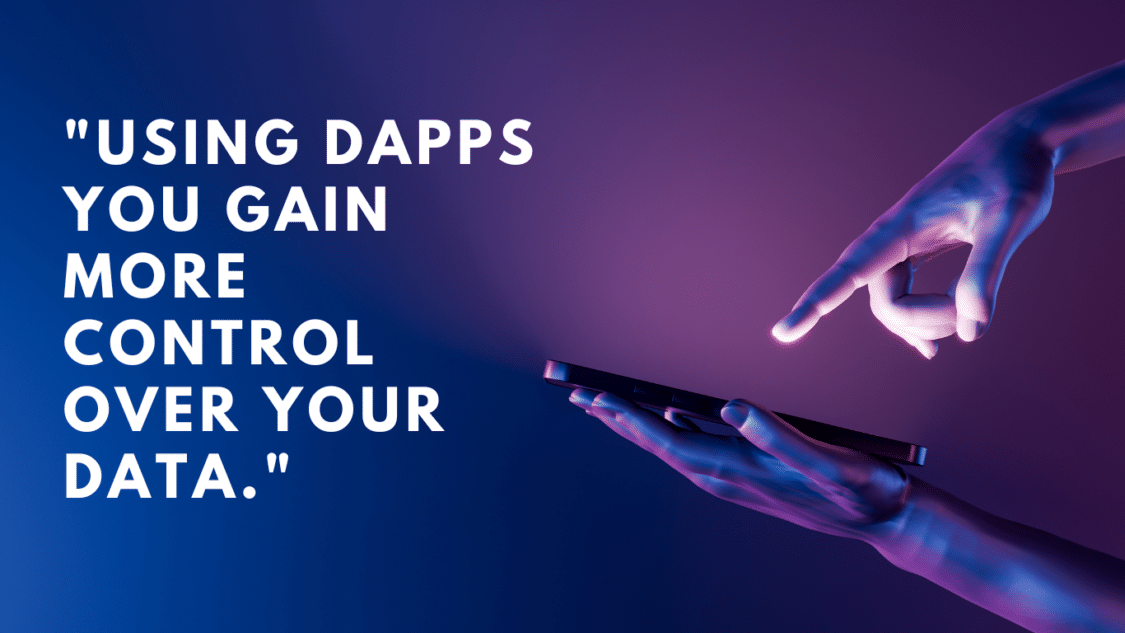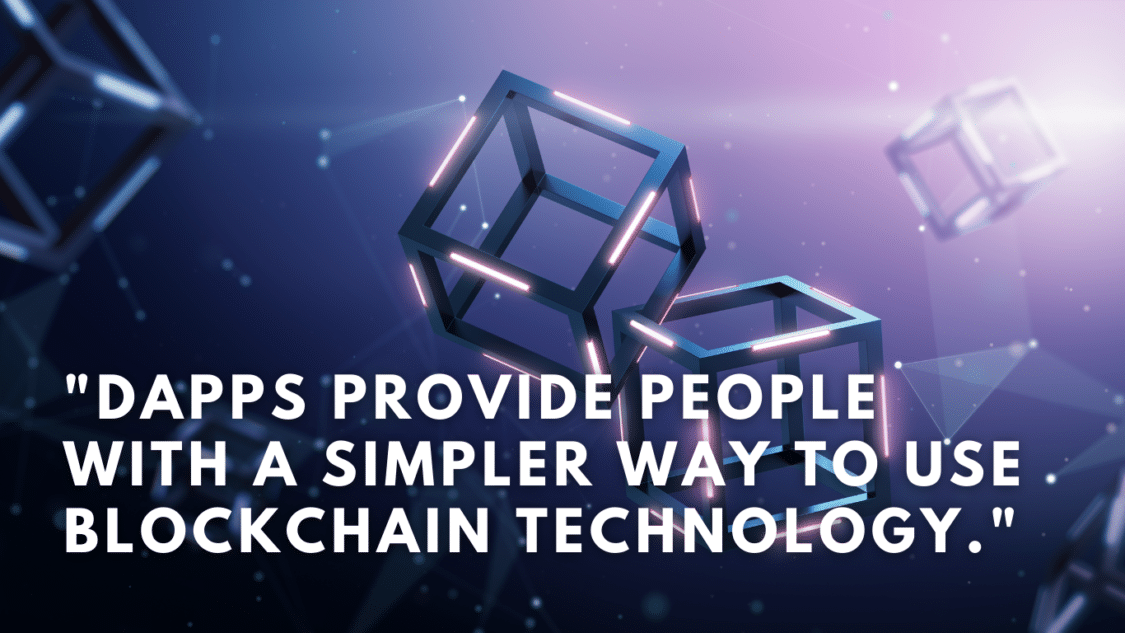A decentralized application, dapps, is a service provider using blockchain technology. The use of blockchain technology eliminates the involvement of an intermediary, which grants users a significant amount of control over their data.
How do dapps work?
Dapps work by using a combination of blockchain technology, smart contracts, and decentralized networks. They are typically built using a programming language like Solidity, specifically designed to create smart contracts.
Once a dapp is created, it is deployed onto a decentralized network like the Ethereum blockchain. From there, it can be accessed by anyone who has a compatible wallet and a connection to the network.
Since dapps are decentralized, they can work without middle people, such as banks or other money-related teach. This makes them more secure and less inclined to censorship, as there’s no single point of disappointment.
Apps
Apps have become helpful on a daily for the majority of people. Some of the many use cases for everyday use involve sending emails, paying for parking, locating nearby stores or restaurants, and many more. In accordance with traditional systems of ownership and control, customers typically give their personal information to the company offering the service.
Dapps
When it comes to a decentralized application, the user gains more control over their data because there is no notion of trusting someone else with their personal info. Some individuals are hesitant to use dapps, but there has been progress. Hundreds of dapps exist today on the Ethereum network, some more efficient than others; however, in the long run, this will give dapps a successful future. Many believe that the upgrade to Ethereum 2.0 can help dapps work smoothly.

Functionality
Decentralized applications on the Ethereum network work hand in hand with blockchain technology to connect users. With a distributed system, where each user has a copy of the records, blockchains provide a means to connect everything. Users don’t have to go through a third party when using blockchain technology, which means they retain control over their data.
Centralized organizations are, by default, in control of the information entering and leaving their networks. Financial institutions, for instance, can prevent transactions from being sent, and Twitter can remove tweets from its site. On dapps, these actions are nearly impossible, which gives users the control they seek.
A decentralized application doesn’t have a precise definition; however, its characteristics can more or less pass on the message.
– The system is open source, meaning that the public has access to the code with permission to look at, copy, and audit it.
– Since no central authority is in charge, users can do what they want on the decentralized app.
– When there is no central authority, how is the app functioning? Dapps use blockchain technology (Ethereum) to keep the network rolling.
– The use of smart contracts on decentralized applications automatically brings specific rules and regulations for the network.
– The globality of dapps allows people worldwide to use the network and its features.

What are the benefits of dapps?
There are several benefits of using dapps. These include:
- Decentralisation: Dapps are decentralised, meaning that any single entity does not control them. This makes them more secure and less inclined to censorship.
- Transparency: Because dapps operate on a public blockchain, all transactions are visible to anyone with access to the network. This makes them more transparent than traditional apps.
- Security: Dapps are more secure than conventional apps, as they are not helpless to hacks or assaults on a central server.
- Trust: Dapps are trustless, meaning they do not need users to authorise a third party to operate. Instead, they rely on the security and transparency of the underlying blockchain technology.
How can developers get involved in the dapp ecosystem?
Developers interested in getting involved in the dapp ecosystem have several options. One of the most popular ways is to learn how to develop smart contracts using a programming language like Solidity.
Many online resources are available for learning how to develop smart contracts, including tutorials, documentation, and online courses. Developers can join online communities, such as forums or social media groups, to connect with other developers and share knowledge.
Once developers have the necessary skills and knowledge, they can start building their own dapps. Several platforms are available for deploying and hosting dapps, including Ethereum, EOS, and Tron.
Developers can also contribute to existing dapps by submitting code, fixing bugs, or contributing to the overall development and maintenance of the dapp.
What are dapps used for?
The Ethereum creator Vitalik Buterin published the Ethereum white paper in 2013, categorizing dapps in three ways.
Financial apps – Applications in which money takes a big part.
Financial applications are also known as decentralized finance or DeFi. To improve financial applications, many have used blockchains such as Ethereum and stablecoins as well as other coins that can stabilize the prices of cryptocurrencies.
Semi-financial apps – Decentralized applications that use money and need additional components, including data from sources other than the Ethereum network. A semi-financial app is similar to a financial app; however, in Buterin’s words, it mixes money with “a heavy non – monetary side.”
Other apps – All other kinds of decentralized apps, such as those for online voting and data storage, that developers are working hard to create. For example, the development of a censorship-resistant, decentralized social network.
What are the challenges of dapps?
While there are many benefits to using dapps, there are also some challenges to consider. These include:
- Complexity: Dapps can be complex to build and operate, requiring specialized knowledge of blockchain technology and smart contract development.
- Scalability: Because dapps work on a decentralized network, they can be slower and less scalable than traditional apps.
- Adoption: Dapps are still relatively new, and adoption is still limited. Because of that, it isn’t easy to find users and build a sustainable business model.
Can you make money with dapps?
Yes, it is possible to make money with dapps, but the revenue model varies depending on the dapp’s purpose and design. Here are some ways that dapps can generate revenue:
- Transaction fees: Many dapps charge transaction fees for using their platform, such as trading fees for decentralized exchanges or gas fees for executing smart contracts.
- Subscription fees: Some dapps offer premium features or services requiring a subscription fee.
- Advertising: Dapps can generate revenue by displaying advertisements to users, similar to traditional apps and websites.
- Token sales: Dapps can issue their tokens, which can be sold to investors to raise funds for development. The tokens can also be used within the dapp’s ecosystem as a form of currency.
- Partnerships and collaborations: Dapps can generate revenue through partnerships and alliances with other companies, such as integrating with existing platforms or providing data analytics services.
Not all dapps are designed with revenue generation in mind, and some are built for non-profit or community-driven purposes. In these cases, revenue generation may not be a priority.
In conclusion, dapps can generate revenue through various means, and the revenue model will depend on the dapp’s design and purpose. However, like any business venture, the success of a dapp depends on various factors, including user adoption, competition, and market demand.
Top dapps examples:
- Uniswap: A decentralized exchange built on Ethereum allows users to trade cryptocurrencies without intermediaries.
- Aave: A decentralized lending and borrowing platform built on Ethereum allows users to earn interest on their cryptocurrency holdings or borrow cryptocurrency.
- Compound: A decentralized lending and borrowing platform built on Ethereum, similar to Aave.
- Chainlink: A decentralized prophet arrangement that gives real-world information to shrewd contracts on various blockchain platforms.
- MakerDAO is a decentralized autonomous organization that issues the stablecoin DAI, backed by collateralized cryptocurrency.
- Decentraland is a decentralized virtual reality stage where clients can possess, build, and monetize their virtual land and experiences.
- Gnosis: A decentralized forecast advertise stage that permits clients to create expectations on real-world events and earn rewards for correct predictions.
- CryptoKitties: A collectible game built on Ethereum, allowing users to breed and trade unique digital cats.
It’s important to note that the popularity of dapps can change rapidly, and new dapps are constantly being developed and launched. Additionally, the success of a dapp depends on several factors, including user adoption, community support, and the overall market demand for the dapp’s purpose and features.
The Future of Decentralized Application

Within the next ten years, the growth of dapps is expected to be great. Although a completely decentralized world is yet to be a reality, Dapps provide people with a simpler way to use blockchain technology. Soon enough, it may become a part of our everyday life, helping cut costs and other benefits.
For more news updates, visit our homepage now and see our latest news article. Want to learn more about trading? Visit our education page now and learn for FREE!

